Ever wondered if you could grow a lush, productive garden in one of Earth’s most challenging environments? You absolutely can—and I’m here to show you exactly how.
When my neighbor first told me she was planning a vegetable garden in our Arizona desert town, I’ll admit I was skeptical. “In this heat?” I thought, watching the thermometer climb past 110°F for the fifth day in a row.
But eight months later, as I sat in her backyard eating the most delicious tomatoes I’d ever tasted while being serenaded by hummingbirds visiting her desert willow trees, I realized I had seriously underestimated what’s possible in the desert.
Desert gardening isn’t just about survival—it’s about creating something beautiful and productive that works with your environment rather than against it. Whether you’re dealing with scorching summers, alkaline soil, or minimal rainfall, this guide will transform your relationship with desert gardening from overwhelming challenge to exciting opportunity.
Understanding Your Desert: The Foundation of Success
Know Your Desert Type
Not all deserts are created equal, and understanding your specific environment is crucial for success.
Low elevation deserts (like Phoenix or Las Vegas) typically experience mild winters with average lows around 20-30°F and brutally hot summers reaching 115°F or higher.

High elevation deserts (like parts of New Mexico or northern Arizona) can see winter lows near 0°F with hot, dry summers.
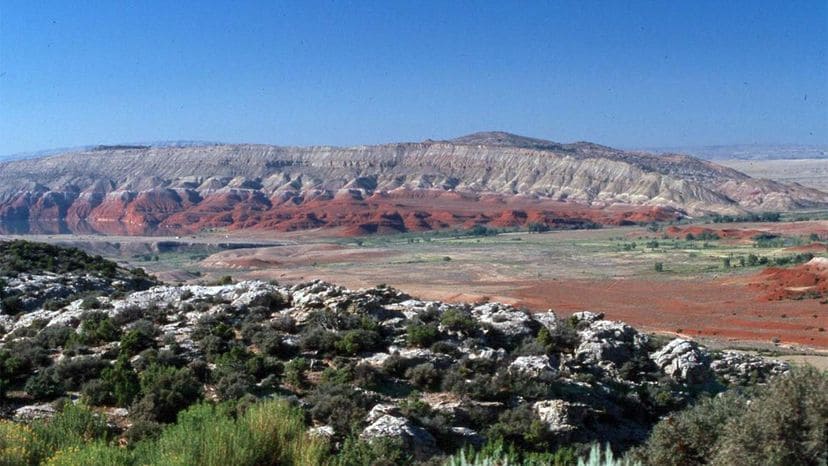
I learned this lesson the hard way during my first year of desert gardening. I planted cold-hardy vegetables in February, thinking I was being clever by getting an early start. Then a late frost hit, and I watched my carefully tended seedlings turn black overnight.
Now I know that understanding your specific microclimate—not just the general desert category—makes all the difference.
The desert environment brings unique challenges:
- Extreme heat that can literally cook plant roots in the soil
- Low humidity (often below 30%) that accelerates water loss
- Intense UV radiation that can scorch leaves
- Strong winds that can damage plants and increase water needs
- Minimal rainfall (often 4 inches or less annually)
Here’s How to Plant on a Slope With Tips and Techniques for a Stunning Hillside Garden
The Secret Seasons of Desert Gardening
Here’s something most newcomers don’t realize: desert gardening actually gives you more growing seasons than traditional climates, not fewer. While other gardeners are limited to spring and summer, desert gardeners can enjoy:
- Spring (March-May): Perfect for warm-season crops before the heat hits. This is your sprint season—plant quickly and get crops established before summer arrives.
- Summer (June-August): Time for heat-lovers like okra and desert-adapted varieties. Many gardeners take a break during the hottest months, using cover crops to protect soil.
- Monsoon (Late Summer/Early Fall): A second chance for warm-season crops. The combination of rain and slightly cooler temperatures creates another planting opportunity.
- Fall/Winter (September-February): The golden season for cool-weather vegetables. This is often the most productive time for desert gardeners, with perfect growing conditions and minimal pest pressure.
The key is working with these natural rhythms instead of fighting them.
Soil: Turning Desert Sand into Garden Gold
Understanding Desert Soil Challenges
Desert soil often looks like it belongs on Mars rather than in a garden—sandy, rocky, and seemingly lifeless. Most desert soils share common characteristics:
- High pH (8.0 or higher) due to minimal rainfall
- Low organic matter (often less than 1%)
- High salt content from mineral-rich irrigation water
- Poor water retention in sandy soils
- Hardpan layers like caliche that block drainage
Here’s the secret: you don’t need to replace your soil entirely. You need to transform it gradually, like building a savings account with small, consistent contributions over time.
Soil Testing: Your Starting Point
Before you begin amending soil, invest in a proper soil test. A complete analysis including pH, nutrient levels, and salt content will guide your improvement strategy. Many university extension services offer comprehensive soil tests for $25-85, providing specific amendment recommendations for your situation.

When I had my soil tested, I was surprised to learn that despite its poor appearance, my desert soil actually had adequate mineral content—it just needed organic matter and pH adjustment to unlock those nutrients.
Building Soil That Works
The Foundation Approach:
Year One – Establishing the Base:
- Add organic matter: Start with 2-3 inches of compost mixed into the top 6-8 inches of soil
- Lower pH gradually: Apply 15-20 pounds of sulfur per 1,000 square feet in spring and fall
- Improve structure: Mix in coarse sand or perlite to enhance drainage
- Introduce biology: Add mycorrhizal fungi and beneficial bacteria
Ongoing Maintenance:
- Apply 1-2 inches of compost twice yearly
- Mulch consistently to feed soil organisms
- Rotate crops to prevent nutrient depletion
- Test soil pH annually and adjust as needed
Here’s How to Add Nitrogen to Soil With 18 Quick Fixes + Long-Term Solutions
Composting in the Desert
Making compost in the desert requires slight modifications to traditional methods, but the intense heat actually accelerates decomposition.
Desert Composting Success:
- Materials to use: Vegetable scraps, coffee grounds, grass clippings, fallen leaves, shredded paper
- Materials to avoid: Meat, dairy, oils, diseased plants, weed seeds
Building Your Pile:
- Create a base layer of coarse material (straw or small branches) for drainage
- Add 3-inch layer of green materials (kitchen scraps, fresh grass clippings)
- Add 6-inch layer of brown materials (dry leaves, shredded paper)
- Add 1-inch layer of garden soil to introduce microorganisms
- Water thoroughly but don’t saturate
- Turn every few days for aeration
In summer heat, I often have finished compost in just 3-4 months. The key is maintaining proper moisture—the pile should feel like a wrung-out sponge.
Raised Beds vs. Sunken Beds: Choosing Your Strategy
1. Raised Beds offer immediate soil control and are perfect for:
- Areas with severe drainage problems
- Contaminated or extremely poor soil
- Accessibility needs
- Beginner gardeners wanting guaranteed success
Here’s How to Build a Wicking Bed: DIY Self‑Watering Raised Garden Guide
2. Sunken Beds are gaining popularity among experienced desert gardeners because they:
- Conserve water by creating natural catchments
- Keep plant roots in cooler soil zones
- Require less initial investment
- Work with natural water flow patterns
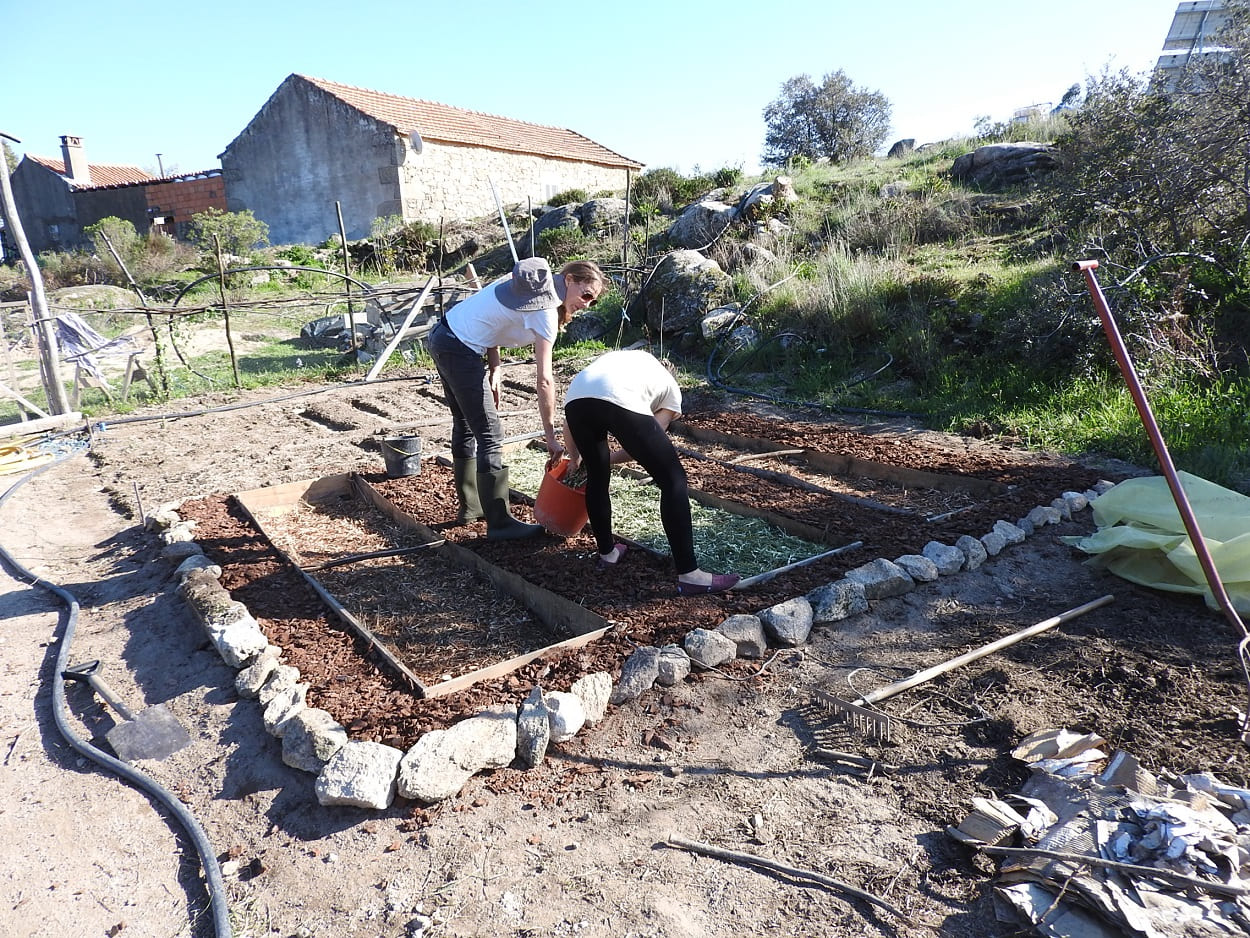
I created my first sunken bed last year using the square-foot method, digging down 6 inches and backfilling with a 50/50 mix of native soil and compost. The results? My summer squash thrived with 30% less water than my raised bed squash.
Building a Sunken Bed:
- Mark out your 4×4-foot square
- Dig down 6 inches, setting aside the soil
- Mix removed soil 50/50 with compost
- Backfill, leaving bed 4 inches below ground level
- Create pathways between beds using landscape fabric and wood chips
- Install grid system for square-foot planting
Water Wisdom: Making Every Drop Count
The Deep Watering Revolution
Forget everything you know about frequent, light watering. In the desert, deep, infrequent watering is your mantra. Shallow watering creates shallow roots, leaving plants vulnerable to heat stress. Deep watering encourages roots to grow down into cooler, more stable soil layers.
My Deep Watering Schedule:
- New seedlings: Light daily watering for first week
- Establishing plants: Deep watering every other day for 2-3 weeks
- Mature vegetables: Deep watering 2-3 times per week
- Native plants: Deep watering weekly or bi-weekly once established
Irrigation Systems That Actually Work
Drip Irrigation Setup: While drip irrigation is excellent for water conservation, desert conditions require specific considerations:
- Emitter spacing: In sandy soil, space emitters closer together (6-12 inches apart) to create overlapping moisture zones
- Multiple emitters: Use 2-4 emitters per large plant rather than one
- Pressure compensation: Use pressure-compensating emitters for consistent flow on slopes
- Summer modifications: Remove or bury lines deeper in summer to prevent overheating
Soaker Hoses: Perfect for row crops and raised beds. I use them for my winter greens and love their even water distribution.
Hand Watering: Don’t underestimate this method for small gardens and containers. It allows you to observe plants closely and adjust watering to individual needs.
Pro tip: In summer, I actually remove my drip lines because the black tubing acts like underground heating elements. Instead, I use flood irrigation for larger areas and hand watering for containers.
Read about Zaï: The Ancient African Farming Technique Revolutionizing Water Conservation
Rainwater Harvesting
Desert rainfall is precious, and capturing it can significantly reduce irrigation costs. A 1,000-square-foot roof can collect about 600 gallons from just one inch of rain.
Simple Rainwater Systems:
- Rain barrels: Position at downspouts to catch roof runoff. Here’s How to Use Goldfish for Mosquito Control in Rain Barrels
- Cisterns: Larger storage for properties with more roof area
- Swales and berms: Direct runoff to planted areas
- Permeable hardscaping: Allow rain to soak in rather than run off
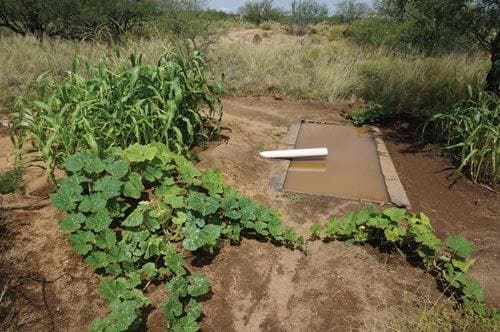
Legal note: Check local regulations—some areas restrict rainwater collection while others offer rebates for installation.
Mulching Magic
Mulch in the desert isn’t just helpful—it’s essential. The right mulch can lower soil temperature by 20°F and reduce water needs by 50%.
- For vegetables and annuals: Organic mulches like straw, shredded leaves, or wood chips. These break down to feed the soil while providing cooling and moisture retention.
- For native and desert-adapted plants: Gravel or decomposed granite. These plants actually prefer mineral mulches and can be susceptible to crown rot from organic mulches holding too much moisture.
Application tips: Apply organic mulch 3-4 inches thick, keeping it 2 inches away from plant stems to prevent pest issues.
Explore Creative Ways to Use Pine Cones in Your Garden
Plant Selection: Choosing Your Green Team
The Native Plant Advantage
Native plants aren’t just environmentally responsible—they’re your secret weapon for low-maintenance gardening success. Plants like palo verde trees, brittlebush, and desert marigolds have spent millennia perfecting their survival strategies for your exact conditions.
Top Native Performers:
- Trees: Mesquite, Palo Verde, Desert Willow, Joshua Tree
- Shrubs: Creosote Bush, Texas Sage, Ocotillo, Bougainvillea
- Perennials: Desert Marigold, Brittlebush, Penstemon, Desert Mallow
- Grasses: Little Bluestem, Pink Muhly Grass
Desert-Adapted Superstars
Don’t limit yourself to natives exclusively. Desert-adapted plants from similar climates worldwide can thrive with minimal intervention:
- Mediterranean classics: Lavender, rosemary, olive trees, cistus
- Mexican natives: Agaves, barrel cacti, desert sage
- Australian imports: Acacia species, eucalyptus varieties
- South African succulents: Aloes, living stones, ice plants
Exploring 21 Popular Cactus Varieties for Beginners and How to Grow Them
Vegetable Gardening Success
Cool-Season Champions (September-March planting):
These vegetables not only tolerate cool weather but often produce better in desert winters than in traditional climates:
- Leafy greens: Lettuce, spinach, kale, chard, arugula
- Root vegetables: Carrots, beets, radishes, turnips
- Brassicas: Broccoli, cabbage, cauliflower, Brussels sprouts
- Alliums: Onions, garlic, leeks, chives
- Legumes: Peas, fava beans
Heat Warriors (March-June and August-September planting):
These vegetables actually thrive in desert heat when given proper care:
- Solanaceae: Tomatoes (cherry varieties best), peppers, eggplant
- Cucurbits: Armenian cucumbers, desert-adapted melons, summer squash
- Heat-lovers: Okra, cowpeas, desert-adapted beans
- Herbs: Basil, oregano, Mexican mint marigold
Explore the Best Herbs for Cut Flower Gardens: 12 Essential Varieties to Grow
Fruit Trees for the Desert
Many fruit trees adapt surprisingly well to desert conditions with proper variety selection and care:
- Stone fruits: Choose low-chill varieties like ‘Desert Gold’ peach or ‘Blenheim’ apricot
- Citrus: Plant in containers for freeze protection or choose cold-hardy varieties
- Figs: Extremely heat and drought tolerant once established. Learn about Harnessing Fig Sap For Natural Remedies, Vegan Cheese, and More
- Pomegranates: Nearly indestructible in desert conditions
- Jujubes: Asian date-like fruits that love heat and drought
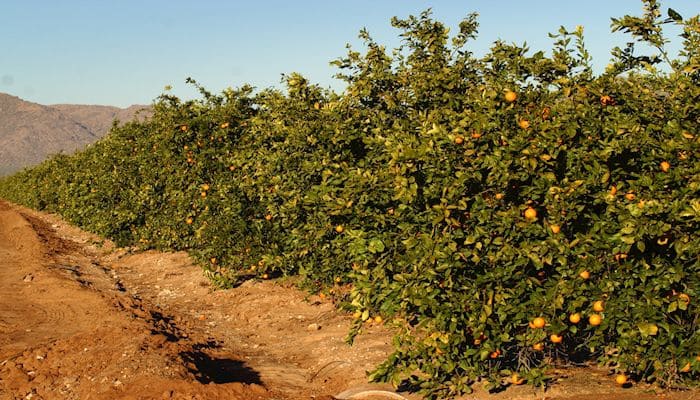
Timing Your Plantings
- Early Spring (February-March): Plant cool-season crops that can mature before summer heat. Use row covers for frost protection.
- Late Spring (March-April): Last chance for warm-season crops before extreme heat. Focus on heat-tolerant varieties.
- Summer (June-August): Plant only the most heat-tolerant crops or use this time for soil improvement and infrastructure projects.
- Early Fall (August-September): Second opportunity for warm-season crops, especially in areas with mild autumns.
- Fall/Winter (September-February): Prime time for cool-season vegetables. Plant every 2-3 weeks for continuous harvest.
Creating Microclimates: Your Garden’s Cool Zones
Strategic Shade Creation
In the desert, shade isn’t luxury—it’s survival equipment for many plants. Creating effective shade requires strategy and understanding of sun patterns.
Living shade strategies:
- Companion planting: Grow tall, heat-tolerant plants like sunflowers or corn to shade delicate crops
- Vertical gardening: Use trellises with climbing plants to create shade walls
- Canopy plants: Establish trees or large shrubs to provide overhead protection
Explore 36 Shade-Loving Herbs and Vegetables That Grow With Less Sunlight
Shade cloth systems: Use 30-50% shade cloth for most vegetables during summer. I’ve found that adjustable shade structures work best—full sun in winter, partial shade in summer.
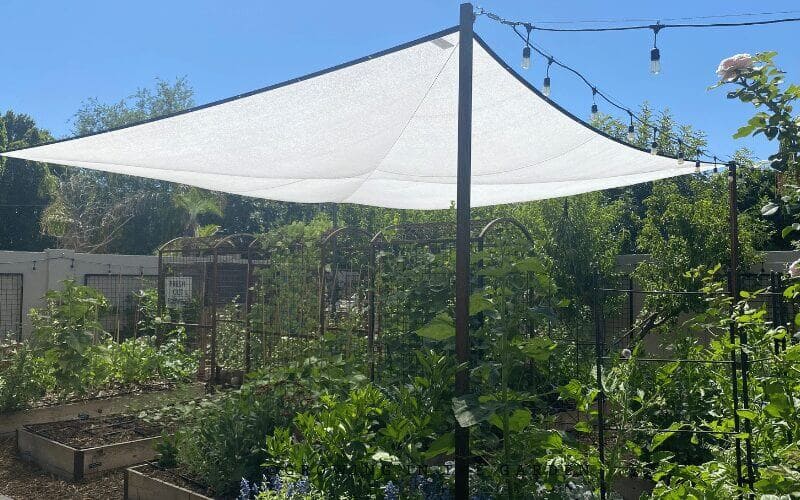
Structural shade: Position garden beds on the east side of buildings or fences to get morning sun but afternoon protection.
Wind Protection Strategies
Desert winds can be devastating, but they’re manageable with the right approach. I learned this after watching my tomato plants get shredded during a spring windstorm.
Effective windbreaks:
- Living barriers: Plant shrubs or install living fences upwind of sensitive areas
- Temporary protection: Use row covers, frost fabric, or temporary screens
- Grouped plantings: Cluster plants together rather than spacing them far apart

Flexible supports: Use bamboo or flexible stakes that bend with wind rather than rigid supports that break under pressure.
Advanced Techniques for Desert Success
Starting Seeds in Desert Conditions
Many vegetables benefit from indoor seed starting, especially during temperature extremes.
Indoor seed starting setup:
- Use sterile potting mix to prevent damping-off disease
- Provide consistent moisture without waterlogging
- Maintain temperatures between 65-75°F for most seeds
- Use grow lights or bright windows for adequate illumination
- Harden off seedlings gradually before transplanting
Pre-sprouting technique: For difficult-to-germinate seeds, try pre-sprouting. Roll seeds in damp cloth, place in labeled jars, and keep at appropriate temperature until sprouting begins, then plant immediately.
Learn about Optimal Soil Temperatures for Seed Germination: A Gardener’s Guide
Transplanting Techniques
- Trench planting: For heat-sensitive crops like tomatoes, dig trenches 6-8 inches deep. Plant seedlings at the bottom and gradually fill in as plants grow. This keeps roots in cooler soil and provides wind protection.
- Water-in method: When transplanting, dig holes and fill with water before placing plants. This ensures roots are surrounded by moist soil from day one.
Cover Crops and Soil Protection
During summer fallows or off-seasons, protect and improve soil with cover crops:
- Summer cover crops: Cowpeas, buckwheat, amaranth
- Winter cover crops: Crimson clover, winter wheat, mustard
- Living mulches: Low-growing plants that suppress weeds while protecting soil
Here’s How to Use Cardboard for Weed Control: Complete Guide to Sheet Mulching
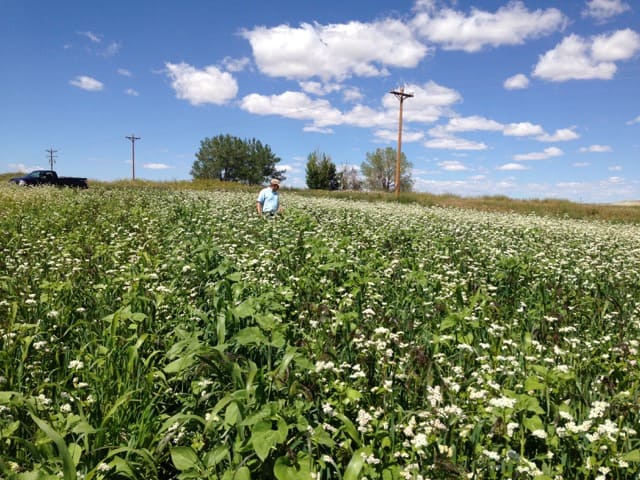
Cover crops not only protect soil from erosion and temperature extremes but also add organic matter when tilled in and can break up hardpan layers with their roots.
Container Gardening Excellence
Container gardening offers unique advantages in the desert—mobility, complete soil control, and protection options.
Container success strategies:
- Size matters: Use containers at least 18 inches wide for vegetables
- Color choice: Light-colored containers reduce heat absorption
- Double-potting: Place planted containers inside larger decorative pots with insulation between
- Mobility: Use plant caddies to move containers to optimal locations seasonally
- Drainage: Ensure excellent drainage but use saucers to reduce water loss
Soil mixes for containers: Combine equal parts compost, perlite, and quality potting soil. Add slow-release fertilizer and water-holding crystals for best results.
Read the Delayed Planting Guide: Tips for Successful Container Tree Care
Seasonal Management Calendar
Spring Tasks (March-May)
- Remove winter protection structures
- Apply compost and fertilizer to beds
- Plant warm-season crops early with protection
- Install or repair irrigation systems
- Mulch beds before heat arrives
Summer Management (June-August)
- Maintain consistent watering schedules
- Harvest heat-tolerant crops
- Install shade structures
- Focus on soil improvement projects
- Plan fall plantings
Fall Preparation (September-October)
- Plant cool-season crops
- Remove summer mulch and replace with fresh material
- Collect and save seeds
- Plan next year’s garden expansion
Here’s How to Turn Fall Leaves into Soil Enriching Mulch For a Nutrient-Rich Garden
Winter Care (November-February)
- Harvest cool-season crops
- Protect tender plants from frost
- Maintain equipment and infrastructure
- Order seeds for next year
- Build and improve garden structures
Pest and Disease Management
Common Desert Garden Pests
- Aphids: Most common in spring and fall. Control with insecticidal soap or strong water sprays.
- Whiteflies: Problematic year-round on susceptible plants. Use yellow sticky traps and beneficial insects.
- Spider mites: Thrive in hot, dry conditions. Increase humidity around plants and use predatory mites.
- Wildlife: Birds, rabbits, and javelinas require physical barriers like netting or fencing.
Learn to Master Natural Pest Control: Top Organic Solutions for Your Garden
Disease Prevention
Desert conditions naturally suppress many fungal diseases, but prevention is still important:
- Proper spacing: Ensure good air circulation between plants
- Drip irrigation: Keep foliage dry to prevent fungal issues
- Crop rotation: Prevent soil-borne disease buildup. Learn the details here!
- Sanitation: Remove diseased plant material promptly
Beneficial Insects and Pollinators
Encourage beneficial insects by:
- Planting native flowering plants
- Avoiding broad-spectrum pesticides
- Providing water sources
- Creating habitat with diverse plantings
Top pollinator plants: Penstemon, desert marigold, lantana, salvia, desert willow
Read The Beginner’s Guide To Attracting Ladybugs To Your Garden
Troubleshooting Common Issues
Blossom End Rot in Tomatoes
- Cause: Inconsistent watering leading to calcium deficiency
- Solution: Maintain consistent soil moisture with mulch and regular watering
Plants Not Establishing
- Cause: Usually poor drainage or inappropriate plant selection
- Solution: Improve drainage, choose desert-adapted varieties, ensure proper planting depth
Salt Buildup in Soil
- Cause: High-salt irrigation water and poor drainage
- Solution: Periodic deep watering to leach salts, improve drainage, consider rainwater harvesting
Stunted Growth Despite Care
- Cause: Often high soil pH preventing nutrient uptake
- Solution: Lower pH with sulfur applications, choose plants tolerant of alkaline conditions
The Economics of Desert Gardening
Initial Investment Considerations
Essential startup costs:
- Soil amendments: $200-500 for average-sized garden
- Irrigation system: $300-800 depending on complexity
- Tools and equipment: $100-300
- Plants and seeds: $100-200 first year
Money-saving strategies:
- Start small and expand gradually
- Share bulk soil amendments with neighbors
- Collect free mulch from tree services
- Propagate plants from cuttings
- Focus on high-value crops like herbs and specialty vegetables
Long-term Economic Benefits
- Water savings: Properly designed desert gardens can reduce water bills by 30-60%
- Food production: A well-managed 4×8-foot bed can produce $600+ worth of vegetables annually
- Low maintenance: Native plants require minimal ongoing inputs once established
- Property value: Attractive, water-wise landscaping increases home values
Frequently Asked Questions
Q: Can I really grow vegetables in 115°F heat?
A: Some vegetables absolutely thrive in extreme heat! Okra, Armenian cucumbers, and desert-adapted peppers actually produce better in intense heat than in milder climates. For heat-sensitive crops, provide afternoon shade and focus on morning sun exposure.
Q: How much water does a desert garden really need?
A: It depends entirely on plant selection and design. Native plant gardens might need supplemental water only during establishment, while vegetable gardens typically use 50-70% less water than traditional gardens when properly designed with drip irrigation and mulching.
- Q: What’s the biggest mistake new desert gardeners make?
A: Trying to recreate gardens from other climates instead of embracing desert advantages. Fighting your environment instead of working with it leads to frustration and failure. Embrace heat-loving plants and winter growing seasons.
- Q: Is it worth starting a garden if I’m just renting?
A: Absolutely! Container gardening and small raised beds can be incredibly productive and portable. I know renters who’ve created amazing productive gardens using just containers and temporary structures that moved with them.
- Q: How do I know if my soil amendments are working?
A: Look for improved water infiltration (water soaks in rather than running off), darker soil color, increased earthworm activity, and better plant performance. These indicate improving soil biology and structure.
- Q: Should I take summers off from gardening?
A: Not necessarily! While many gardeners do scale back in summer, it’s a great time for heat-loving crops, infrastructure projects, and soil improvement. Even if you don’t grow food crops, summer cover crops can improve your soil for fall planting.
Your Desert Garden Journey Starts Now
Creating a thriving desert garden isn’t about conquering a harsh environment—it’s about partnership.
The desert offers unique advantages that other climates can’t match: intense sunshine for rapid plant growth, minimal pest and disease pressure, extended growing seasons, natural pest control from low humidity, and the deep satisfaction of creating an oasis in an unlikely place.
Your Action Plan:
- Week 1: Choose your garden location and test your soil
- Week 2: Design your space and order amendments
- Week 3: Begin soil preparation and install basic infrastructure
- Week 4: Plant your first crops based on current season
Start small with a 4×4-foot bed or a few containers. Focus on easy wins like lettuce in winter or heat-loving herbs in summer. Each success builds confidence and knowledge for expanding your garden.
Remember that every master desert gardener was once a beginner who wondered if anything would grow in this seemingly impossible environment.
The desert has supported agriculture for thousands of years—from the ancient Hohokam irrigation systems in Arizona to the terraced gardens of Pueblo peoples. You’re joining a long tradition of creative adaptation and abundance.
Your garden is waiting—not for perfect conditions, but for you to begin. Start with one bed, one season, one small success. Before you know it, you’ll be harvesting fresh tomatoes in November while your friends in other climates are dealing with frost, and you’ll understand the true magic of desert gardening.
Welcome to the community of desert gardeners. Your oasis awaits!
